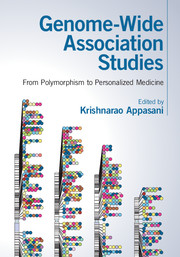Book contents
- Frontmatter
- Dedication
- Contents
- List of contributors
- Forewords
- Preface
- List of abbreviations
- Part I Genome-wide association studies
- Part II Genome-wide studies in disease biology
- Part III Single nucleotide polymorphisms, copy number variants, haplotypes and eQTLs
- 10 Finding SNPs that affect microRNA regulation in disease-associated genomic regions
- 11 From linkage to complex associations: the role of GABRA2 as a risk factor for alcohol use
- 12 Copy number variation in monozygous twins
- 13 Haplotypes of CpG-related SNPs and associations with DNA methylation patterns
- 14 eQTL mapping
- Part IV Next-generation sequencing technology and pharmaco-genomics
- Part V Population genetics and personalized medicine
- Index
- Plate section
- References
11 - From linkage to complex associations: the role of GABRA2 as a risk factor for alcohol use
from Part III - Single nucleotide polymorphisms, copy number variants, haplotypes and eQTLs
Published online by Cambridge University Press: 18 December 2015
- Frontmatter
- Dedication
- Contents
- List of contributors
- Forewords
- Preface
- List of abbreviations
- Part I Genome-wide association studies
- Part II Genome-wide studies in disease biology
- Part III Single nucleotide polymorphisms, copy number variants, haplotypes and eQTLs
- 10 Finding SNPs that affect microRNA regulation in disease-associated genomic regions
- 11 From linkage to complex associations: the role of GABRA2 as a risk factor for alcohol use
- 12 Copy number variation in monozygous twins
- 13 Haplotypes of CpG-related SNPs and associations with DNA methylation patterns
- 14 eQTL mapping
- Part IV Next-generation sequencing technology and pharmaco-genomics
- Part V Population genetics and personalized medicine
- Index
- Plate section
- References
Summary
Introduction
Alcohol use disorder (AUD) is partially under genetic control due to common variants in several genes, each of small effect. Most relevant to AUD, in addition to genetic risk, environmental exposures play important roles in the development of AUD. It is increasingly recognized that genetic and environmental factors depend on each other, suggesting that the expression of genetic liability depends on environmental factors. Furthermore, risk factors known as intermediate phenotypes are under the same gene–environment influence and may provide important clues to further understand this heterogeneous disorder. With this in mind, we review more than a decade of interdisciplinary research on the role of the gamma-aminobutyric acid-Aα2 (GABRA2) gene on the risk of developing AUD. The initial evidence came from wide genome studies in alcoholic families, followed by electrophysiological measures and replication studies in case-control designs. Going further, the study of GABRA2 extended to risk factors (i.e., impulse control) imaging and environment during development. This plethora of evidence and interdisciplinary research emphasizes the importance of converging different lines of investigation to understand the interplay between genetic risk (or resilience) and environmental factors in the development of AUD.
GABRA2 structure and function
The gamma-aminobutyric acid (GABA) system is the major inhibitory system in the central nervous system (CNS) with a major role in homeostatic neuronal plasticity processes. Voltage-dependent conductance and fine-tuning of synaptic strength are two mechanisms by which plasticity operates in neurons (Onori et al., 2010).
GABA type A (GABA-A) receptors can be found in the GABA synapse or periphery (mediate tonic inhibition). Synaptic receptors mediate a phasic, high-chloride conductance GABA response and respond to benzodiazepine agonist stimulation. GABA-A receptors are pentamers with combinations of seven different subunit classes. Typically, GABRA2 is found in the synaptic receptors. Sensitivity to the ligand GABA depends on the α subunit present in receptors that contain α, β, and γ subunits. The order of sensitivity is α6<α1<α2<α4<α5<<α3 (Reich et al., 1998).
GABRA2 mRNA shows different splicing forms and alternative promoter use resulting in many isoforms present in human brain (Tian et al., 2005). Genetic differences may account for this complexity with different complex patterns of expression in brain regions.
- Type
- Chapter
- Information
- Genome-Wide Association StudiesFrom Polymorphism to Personalized Medicine, pp. 151 - 167Publisher: Cambridge University PressPrint publication year: 2016

